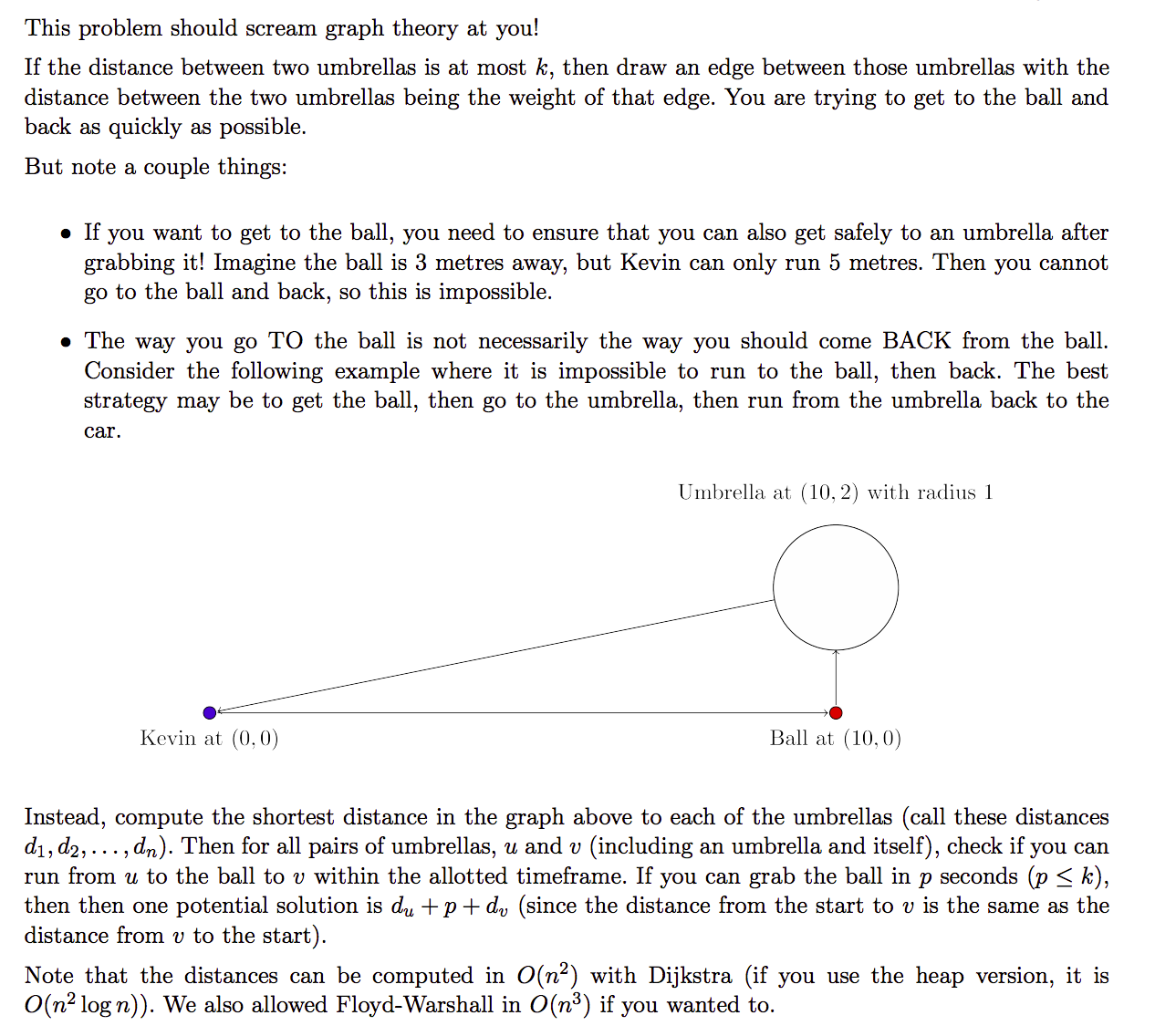Keeping Cool
Description
Kevin has just gotten back to his car after a morning at the beach and is about to drive away when he realises that he has left his ball somewhere. Thankfully, he remembers exactly where it is! Unfortunately for Kevin, it is extremely hot outside and any sand that is exposed to direct sunlight is very hot. Kevin’s pain tolerance allows him to only run for at most k seconds in the hot sand at one time. Kevin runs at exactly 1 metre per second on hot sand. Scattered around the beach are umbrellas. Each umbrella is a perfect circle and keeps the sand underneath it cool. Each time Kevin reaches an umbrella, he will wait there until his feet cool down enough to run for another k seconds on the hot sand. Note that Kevin will not run more than k seconds in the hot sand at one time, so if two umbrellas are more than k metres apart, Kevin will not run between them. Determine the minimum amount of time that Kevin must be in the sun in order to retrieve his ball and return back to the car.

Input
The first line of input contains four integers n (0 ≤ n ≤ 100), which is the number of umbrellas, k (1 ≤ k ≤ 100), which is the number of metres that Kevin can run on the hot sand, x (−100 ≤ x ≤ 100) and y (−100 ≤ y ≤ 100), which are the coordinates of the beach ball. Kevin starts at his car at (0; 0). You may treat Kevin and the ball as single points. The next n lines describe the umbrellas. Each of these lines contains three integers x (−100 ≤ x ≤ 100), y (−100 ≤ y ≤ 100) and r (1 ≤ r ≤ 100). The umbrella is a circle centred at (x; y) with radius r. There may be multiple items (ball, umbrella(s) or Kevin) at a single location. All measurements are in metres.
Output
Display the minimum amount of time (in seconds) that Kevin must be in the sun. If it is impossible for Kevin to get to the ball and return back to the car, display -1 instead. Your answer should have an absolute or relative error of less than 10−6.
Sample Input
0 1 0 0
0 20 1 2
0 10 20 20
2 2 7 4
6 2 2
2 2 1
1 2 3 3
0 3 2Sample Output
0.0000000000
4.4721359550
-1
6.1289902045
4.0000000000链接
https://cn.vjudge.net/problem/CSU-2110
题意
小K在海滩上玩完后开车准备回去时想起他的球掉了,但是他记得球的位置,所以他打算去捡球。由于外面天气太热,小K每次最多可以走k秒(1m/s)。幸运的是,在海滩上有很多遮阳伞![]() ,他可以先去伞下休息然后再接着去找球。现给定伞的位置和球的位置以及小K的初始位置,问小K能否找到球并且成功返回。如果能输出小K在太阳
,他可以先去伞下休息然后再接着去找球。现给定伞的位置和球的位置以及小K的初始位置,问小K能否找到球并且成功返回。如果能输出小K在太阳![]() 下走的最短时间。
下走的最短时间。
- 如果两把伞之间的距离小于等于k,那么它们可以互相到达
- 在遮阳伞的范围之内休息不算在太阳
 下走的时间
下走的时间
题解
最短路变形题,使用Dijkstra即可,时间复杂度$O(n^2)$。但是要注意两点:
- 小K在捡到球后能否成功返回,
0 5 3 0应该输出-1而不是6 - 返回的路径与出发的路径并不一定相同
1 6 5 0 5 2 1应该输出10.38...而不是10.77...
题解给的做法如下:
首先跑一遍最短路,得到起点到每个伞的最短距离d1,d2...dn
然后对于所有的伞,看能否在规定的时间从伞u到球p再到伞v,u可能等于v
如果能那么答案就是,du + dv + 伞到球 + 球到伞时间
同时也要考虑到它可以先捡球然后去伞下,最后返回
代码
| Status | Accepted |
|---|---|
| Time | 4ms |
| Memory | 2132kB |
| Length | 3353 |
#include <iostream>
#include <cstdio>
#include <algorithm>
#include <cstring>
#include <cmath>
using namespace std;
const double eps = 1e-15;
const int inf = 0x3f3f3f3f;
const int maxn = 110;
double G[maxn][maxn];
double dis[maxn];
bool vis[maxn];
struct node
{
int x, y, r;
}a[maxn];
int s, t;
double dist(double x1, double y1, double x2, double y2)
{
return sqrt((x2 - x1) * (x2 - x1) + (y2 - y1) * (y2 - y1));
}
void dijkstra(int n)
{
for (int i = 0; i <= n; ++i)
{
dis[i] = inf * 1.0;
vis[i] = 0;
}
dis[s] = 0.0;
for (int i = 0; i <= n; ++i)
{
double Min = inf * 1.0;
int k = -1;
for (int j = 0; j <= n; ++j)
{
if (dis[j] < Min && !vis[j])
{
Min = dis[j];
k = j;
}
}
if (k == -1)
break;
vis[k] = true;
for (int j = 0; j <= n; ++j)
{
if (G[k][j] + Min < dis[j] && !vis[j])
dis[j] = Min + G[k][j];
}
}
}
int main()
{
int n, k, x, y;
scanf("%d%d%d%d", &n, &k, &x, &y);
s = 0, t = n + 1;
for (int i = 0; i <= n + 1; ++i) // 初始化
for (int j = 0; j <= n + 1; ++j)
G[i][j] = ((i == j) ? 0.0 : inf * 1.0);
double d0 = dist(0.0, 0.0, x * 1.0, y * 1.0);
if (d0 * 2 <= k * 1.0) // 起点与球建边
G[0][n+1] = G[n+1][0] = d0;
for (int i = 1; i <= n; ++i)
scanf("%d%d%d", &a[i].x, &a[i].y, &a[i].r);
for (int i = 1; i <= n; ++i) // 伞与起点和终点建边
{
double d1 = dist(0.0, 0.0, a[i].x * 1.0, a[i].y * 1.0) - a[i].r * 1.0;
double d2 = dist(x * 1.0, y * 1.0, a[i].x * 1.0, a[i].y * 1.0) - a[i].r * 1.0;
if (d1 <= 0.0)
G[0][i] = G[i][0] = 0.0;
else if (d1 <= k * 1.0)
G[0][i] = G[i][0] = d1;
if (d2 <= 0.0)
G[n+1][i] = G[i][n+1] = 0.0;
else if (d2 <= k * 1.0)
G[n+1][i] = G[i][n+1] = d2;
}
for (int i = 1; i <= n; ++i) // 伞间建边
for (int j = 1; j <= n; ++j)
if (j != i)
{
double d = dist(a[i].x, a[i].y, a[j].x, a[j].y) - (a[i].r + a[j].r) * 1.0;
if (d <= 0.0)
G[i][j] = G[j][i] = 0.0;
else if (d <= k * 1.0)
G[i][j] = G[j][i] = d;
}
dijkstra(n);
double ans = G[0][n+1] * 2.0;
for (int i = 1; i <= n; ++i)
{
for (int j = 1; j <= n; ++j) // 起点->伞->球->伞->起点
{
if (G[i][n+1] + G[j][n+1] <= k * 1.0)
ans = min(ans, dis[i] + dis[j] + G[i][n+1] + G[j][n+1]);
}
if (d0 + G[n+1][i] <= k * 1.0) // 起点->球->伞->起点
ans = min(ans, d0 + G[n+1][i] + dis[i]);
}
if (ans - (inf * 1.0) > eps)
printf("-1\n");
else
printf("%.10f\n", ans);
return 0;
}这道题想了两天多,最后在题解的帮助下终于写出来了,给的代码完全看不懂![]() 。这并不是最悲哀的,最悲哀的是,我写完题解之后贴上去发现只有一半,而且并没有备份保存,所以这是第二次编辑,心情不爽
。这并不是最悲哀的,最悲哀的是,我写完题解之后贴上去发现只有一半,而且并没有备份保存,所以这是第二次编辑,心情不爽![]() ,发现竟然是emoji表情的锅!
,发现竟然是emoji表情的锅!

The end.
2018-05-23 星期三
重新写一遍花了我十几分钟 @(呵呵)